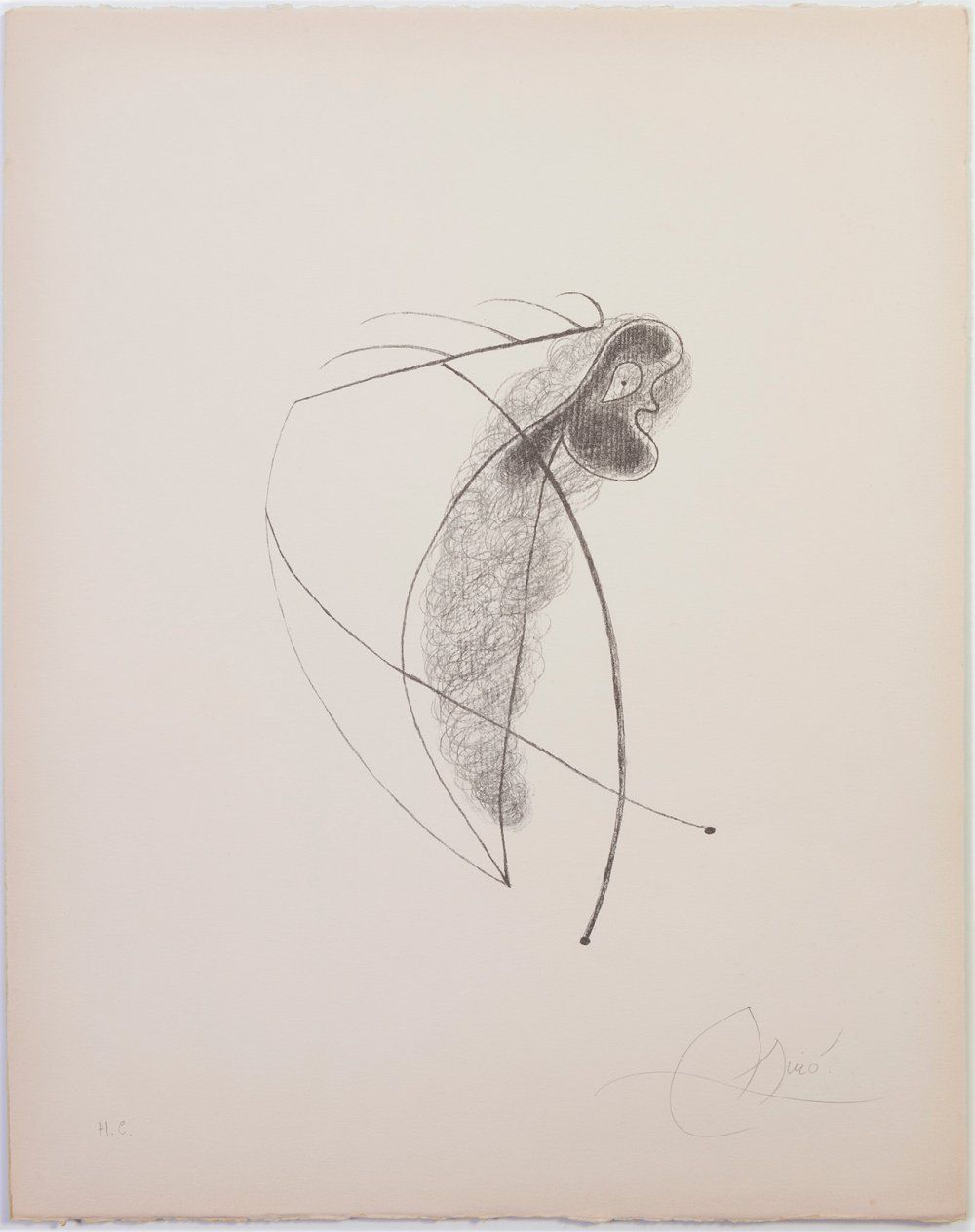Description
JOAN MIRÓ I FERRÀ (Barcelona, 1893 - Palma de Mallorca, 1983). "Lithograph III", 1930 (published in 1973). Lithograph on Arches vellum paper, copy H.C. Sala Gaspar, Barcelona - Galerie Gérald Cramer, Geneva, publishers. Damià Caus printer, Barcelona. Signed and numbered in pencil. Measurements: 56,5 x 45,2 cm. Work published in "Miró lithograph vol. VI: 1976-1981", by Patrick Cramer, p. 195 (Barcelona; Polígrafa, 1987). Print run of 50 copies on Arches vellum (56.5 x 45.2 cm), signed and justified on 50, published in 1973. Joan Miró trained in Barcelona, between the Escola de la Lonja and the Galí Academy. As early as 1918 he held his first exhibition at the Galerías Dalmau in Barcelona. In 1920 he moved to Paris and met Picasso, Raynal, Max Jacob, Tzara and the Dadaists. There, under the influence of the surrealist poets and painters, he gradually matured his style; he tried to transpose surrealist poetry to the visual, based on memory, fantasy and the irrational. From this point onwards his style began to evolve, leading him to more ethereal works in which organic forms and figures were reduced to abstract dots, lines and patches of colour. In 1924 he signed the first Surrealist manifesto, although the evolution of his work, which is too complex, makes it impossible to ascribe him to any particular orthodoxy. His third exhibition in Paris in 1928 was his first great triumph: the Museum of Modern Art in New York acquired two of his works. He returned to Spain in 1941, and that same year the museum devoted a retrospective to him which was to be his definitive international consecration. During the 1950s he experimented with other artistic media, such as engraving, lithography and ceramics. From 1956 until his death in 1983, he lived in Palma de Mallorca in a sort of internal exile, while his international fame grew. Throughout his life he received numerous awards, such as the Grand Prizes at the Venice Biennale in 1954 and the Guggenheim Foundation in 1959, the Carnegie Prize for Painting in 1966, the Gold Medals of the Generalitat de Catalunya (1978) and of the Fine Arts (1980), and was named Doctor Honoris Causa by the universities of Harvard and Barcelona. His work can currently be seen at the Joan Miró Foundation in Barcelona, inaugurated in 1975, as well as in major contemporary art museums around the world, such as the Thyssen-Bornemisza, the MoMA in New York, the Reina Sofía Museum in Madrid, the National Gallery in Washington, the MNAM in Paris and the Albright-Knox Art Gallery in Buffalo.
38
JOAN MIRÓ I FERRÀ (Barcelona, 1893 - Palma de Mallorca, 1983). "Lithograph III", 1930 (published in 1973). Lithograph on Arches vellum paper, copy H.C. Sala Gaspar, Barcelona - Galerie Gérald Cramer, Geneva, publishers. Damià Caus printer, Barcelona. Signed and numbered in pencil. Measurements: 56,5 x 45,2 cm. Work published in "Miró lithograph vol. VI: 1976-1981", by Patrick Cramer, p. 195 (Barcelona; Polígrafa, 1987). Print run of 50 copies on Arches vellum (56.5 x 45.2 cm), signed and justified on 50, published in 1973. Joan Miró trained in Barcelona, between the Escola de la Lonja and the Galí Academy. As early as 1918 he held his first exhibition at the Galerías Dalmau in Barcelona. In 1920 he moved to Paris and met Picasso, Raynal, Max Jacob, Tzara and the Dadaists. There, under the influence of the surrealist poets and painters, he gradually matured his style; he tried to transpose surrealist poetry to the visual, based on memory, fantasy and the irrational. From this point onwards his style began to evolve, leading him to more ethereal works in which organic forms and figures were reduced to abstract dots, lines and patches of colour. In 1924 he signed the first Surrealist manifesto, although the evolution of his work, which is too complex, makes it impossible to ascribe him to any particular orthodoxy. His third exhibition in Paris in 1928 was his first great triumph: the Museum of Modern Art in New York acquired two of his works. He returned to Spain in 1941, and that same year the museum devoted a retrospective to him which was to be his definitive international consecration. During the 1950s he experimented with other artistic media, such as engraving, lithography and ceramics. From 1956 until his death in 1983, he lived in Palma de Mallorca in a sort of internal exile, while his international fame grew. Throughout his life he received numerous awards, such as the Grand Prizes at the Venice Biennale in 1954 and the Guggenheim Foundation in 1959, the Carnegie Prize for Painting in 1966, the Gold Medals of the Generalitat de Catalunya (1978) and of the Fine Arts (1980), and was named Doctor Honoris Causa by the universities of Harvard and Barcelona. His work can currently be seen at the Joan Miró Foundation in Barcelona, inaugurated in 1975, as well as in major contemporary art museums around the world, such as the Thyssen-Bornemisza, the MoMA in New York, the Reina Sofía Museum in Madrid, the National Gallery in Washington, the MNAM in Paris and the Albright-Knox Art Gallery in Buffalo.
